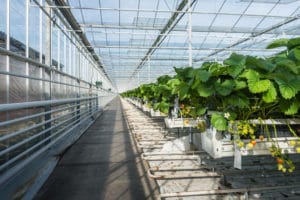Why Hydroponics Is Not Organic
[This article was previously published in the fall issue of The Cultivator, Cornucopia’s quarterly newsletter.]
by Linley Dixon, Senior Scientist at The Cornucopia Institute
 |
Every year, after the first frosty cold rolls over the mountains and puts an end to the outdoor growing season here in Colorado, I dust off the indoor grow lights and boxes of inert grow mats.
Exhausted from months of real organic farming, I look forward to sipping coffee in my jammies while tending to microgreens in the back room of my home. The in-floor hot water heating system is ideal for germinating seeds all winter long under stacks of grow lights.
The hours are flexible; under such controlled conditions, the seedlings don’t care if it is morning, noon, or night when I harvest them. Not a speck of dirt gets under my fingernails, nor does a ray of sunshine hit my face; I don’t even have to put on boots.
There’s nothing wrong with producing a hydroponic crop in the dead of winter to help supplement our diversified small farm’s income, but by no means would I consider it organic farming!
In contrast, organic farming creates fertile soils by integrating systems that add organic matter and cycle nutrients on the farm. These practices include rotational grazing, multi-species cover cropping, composting, and mulching.
Most producers within the organic community understand that the most important, and challenging, aspect of organic farming is ensuring that organic matter and fertility in the soil is maintained or increased.
This is accomplished by costly, but environmentally critical, practices that prevent nutrient run-off, capture carbon in the soil, and provide a humane life for farm animals. These practices are solutions to the biggest environmental issues of our time: climate change, erosion, declining aquifers, and eutrophication of lakes and rivers.
The economic survival of authentic organic farmers depends on enforcement of the laws requiring these practices, without which these farms face the serious risk of being outcompeted by agribusinesses using less expensive and unsustainable production practices under the same organic label.
Rather than cycling nutrients on the farm, hydroponic operations use inert media and apply a continuous supply of liquid nutrients, commonly from hydrolyzed conventionally grown soybeans.
For berry producers (e.g., Driscoll’s), the inert growing media is usually peat moss mined from wetland bogs, robbing carbon from the soil. For tomato, cucumber, and pepper producers (e.g., Wholesum Harvest), the inert media is commonly coco coir from ground up coconut shells.
These mediums are not designed to add any nutrient value, but rather to hold the roots while the plants are fed with a liquid fertilizer solution.
There is nothing required on the label of these “organic” products that helps informed consumers choose.
The controversy over whether or not hydroponics could be considered for USDA organic certification gets at the very heart of the definition of organic agriculture. Currently, the heated debate on the issue continues on the National Organic Standards Board (NOSB).
On August 14, the NOSB held an unprecedented two-hour conference call to discuss whether or not hydroponic systems should be considered under the organic label. The call was scheduled to help the Crops Subcommittee write related proposals for the fall NOSB meeting in Jacksonville, Florida.
NOSB members were strongly divided on the issue—a compromise could not be reached. It seems that pro-hydroponic NOSB members believe the organic label is appropriate for any crop produced without the use of prohibited materials.
In contrast, pro-soil NOSB members maintain that organic production is also defined by what farmers are doing (i.e., diversifying fields, rotating animals on pasture, practicing no-till, etc.), rather than simply what they are not doing (i.e., using toxic chemicals).
At the upcoming NOSB meeting, if two-thirds of the board cannot be convinced to vote for, or against, |the organic certification of hydroponic production, what will remain is a state of confusion, where individual certifiers are allowed to decide for themselves whether or not hydroponic producers meet USDA organic standards.
These decisions will be based on the current regulations, previous NOSB recommendations, and conflicting messages from the National Organic Program.
The NOSB recommended in 2010 to prohibit the organic certification of hydroponics stating, in part, “Growing media shall contain sufficient organic matter capable of supporting natural and diverse soil ecology. For this reason, hydroponic and aeroponic systems are prohibited.”
However, they noted that there are some exceptions for the soil requirement, including transplants, mushrooms, honey, aquatic plants, and microgreens.
The 2010 recommendation came after years of public comment and input from the organic community. Since corporate agribusiness didn’t like the outcome, the corporate-friendly USDA is now forcing us to go through the process all over again.
This time around, large industrial hydroponic growers are organized, forming an “astroturf group,” a lobbying effort masquerading as a grassroots organization: “The Coalition for Sustainable Organics,” otherwise coined “The Coalition for Sustainable Profits” by pioneering organic farmers who are fighting back.
The coalition’s chief lobbyist, Anne McMillan, was deputy chief of staff to former USDA Secretary Tom Vilsack. These ties have enabled her to testify before Congress twice so far to lobby on behalf of hydroponics.
While the NOSB prolongs a decision on standards, the European Parliament tightened its ban on organic hydroponics this past June.
They reached a preliminary agreement to prohibit “demarcated beds,” the container production system where liquid nutrients are routinely applied, under the organic label.
This debate is about ensuring the very survival of the sustainable, diversified farms that built and grew the organic movement—the farms that are currently producing the nutrient-dense, flavorful produce we all have come to love.
It is a sad day when corporate influence over USDA organic has reduced its meaning to simply prohibited inputs, rather than truly integrated production systems.
Fertilizing plants with a liquid solution of predominantly conventional soybeans is not “organic!” Let’s hope a few more NOSB members can be persuaded to agree that there’s simply more to it than that!

